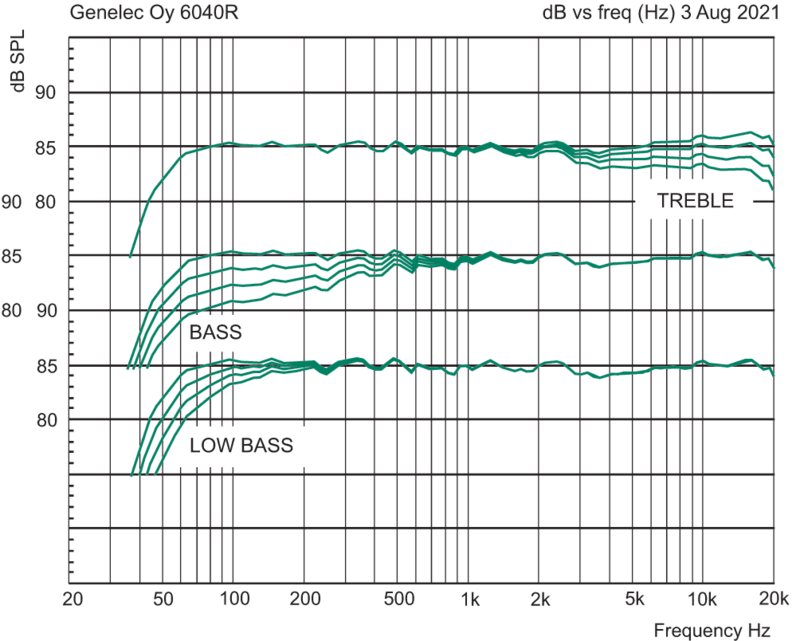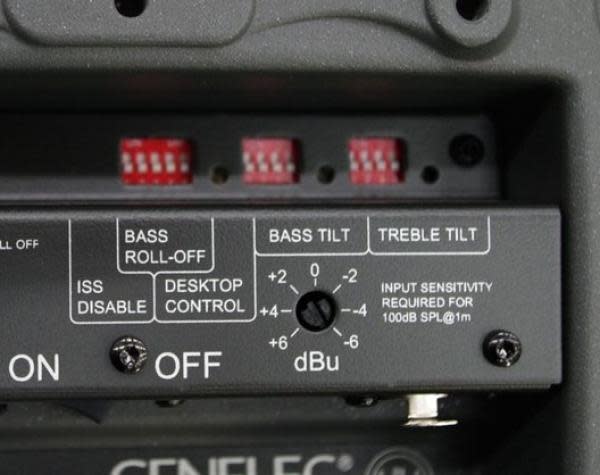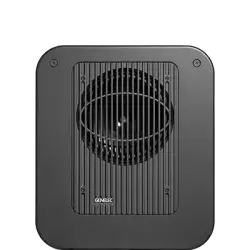The 6040R fuses the very best of Finnish technology and design, bringing exceptional performance and beautiful aesthetics to all lovers of high quality audio.
6040R
Smart Active Loudspeaker

Smart Active Monitoring (SAM™) and GLM™ calibration technology

Directivity Control Waveguide (DCW™) Technology

SPL
109 dB

Frequency Response
43 Hz - 20 kHz (-6 dB)

Dimensions
H 999 x W 237 x D 220 mm, (view in inches)

A loudspeaker ahead of its time
20 years after the launch of the original 6040A, the newly re-imagined 6040R now features professional grade LF drivers, proprietary Class D power amplifiers, and tight integration with our GLM calibration software. This allows the 6040R to deliver clean performance, a consistently smooth frequency response, precise imaging and low distortion – even in challenging acoustic environments.

Pure sound. Finnish design.
Created in close collaboration with leading designer Harri Koskinen, the fluid curves of the 6040R are fashioned from die-cast recycled aluminium. Not only does this design approach create more truthful, less coloured loudspeaker performance, it also means that the 6040R will become the aural and visual centrepiece of any listening environment. Built to the highest environmental standards, the 6040R will provide decades of trouble-free performance.
Genelec
6040R Smart Active Loudspeaker White, White Grille
6040R Smart Active Loudspeaker Black, Black Grille
6040R Smart Active Loudspeaker White, Black Grille
6040R Smart Active Loudspeaker Black, White Grille
6040R Smart Active Loudspeaker Grey
6040R
Awards
Technical Specifications

SPL
109 dB

Amplifier Power
150 W Treble (Class D) + 150 W Bass (Class D)

Frequency Response
43 Hz - 20 kHz ("-6 dB")

Accuracy of Frequency Response
± 1.5 dB (50 Hz - 20 kHz)

Driver Dimensions
⌀ 165 mm Bass + ⌀ 19 mm Treble (view in inches)

Dimensions
H 999 x W 237 x D 220 mm, (view in inches)

Weight
14.9 kg / 32.8 lb

Connections
1 x XLR Analog Input
1 x XLR AES/EBU Input
1 x XLR AES/EBU Output
2 x RJ45 Control
6040R Product Specifications
Smart Active Loudspeaker
Technical Specifications
The 6040R fuses the very best of Finnish technology and design, bringing exceptional performance and beautiful aesthetics to all lovers of high quality audio.

System Specifications
Frequency Response
50 Hz - 20 kHz (± 1.5 dB)
Low cutoff -6dB
43 Hz
High cutoff -6dB
20 kHz

SPL
Peak SPL Maximum peak acoustic output per pair in a listening room with music material at 1 m.
≥118 dB
Short term max SPL Maximum short term sine wave acoustic output on axis in half space, averaged from 100 Hz to 3 kHz at 1 m.
≥109 dB
Long term max SPL Maximum long term RMS acoustic output in the same conditions with IEC weighted noise (limited by driver protection circuit) at 1 m.
≥98 dB
Self-generated noise
Self-generated noise Self generated noise level in free space at 1 m on axis (A-weighted).
≤5 dB SPL
Weight
Weight14.9 kg (32.8 lb)
Dimensions
Height
999 mm
Width
237 mm
Depth
220 mm

Enclosure
Enclosure material
Die cast aluminium
Enclosure type
Sealed box
Drivers
Driver type
Cone
Magnetically shielded bass driver.
Diameter
165 mm
Driver type
Metal dome
Magnetically shielded treble driver.
Diameter
19 mm
Directivity


Harmonic distortion
Group delay
The latency at high frequencies from the input to the acoustic output, measured in the analog input:
Extended Phase Linearity in GLM set to OFF
2.9 ms
In Genelec performance graphics, the time of converting the from an electronic input signal to the acoustic output in a Genelec monitor is described by two factors – latency and group delay. The group delay factor can be read in the graphics for a specific frequency. The total frequency-specific input-to-output delay is a sum of the latency and group delay factors. To understand the significance of this total delay, consider that moving a loudspeaker away by 1 meter creates an additional delay of about 3 ms.
Amplifier Section
Amplifiers
150 W Class D
150 W Class D
Mains voltage
100-240 VAC 50/60Hz
Power consumption
ISS Active
≤1 W
Idle
≤12 W
Full output
180 W
Signal processing section
Connectors
Input Analog signal input connector XLR female, balanced 10 kOhm.
Input Digital signal input connector XLR female 110 Ohm.
Output Digital signal output / Thru connector XLR male 110 Ohm.
2 x Control Two CAT5 (RJ45) GLM Network connectors for computer control using the Genelec Loudspeaker Manager (GLM) software.
Product Variants
Product codes
Compatible Accessories
Product codes
For even more technical details please see product operating manual.
Key Technologies

Smart Active Monitoring (SAM™) and GLM™ calibration technology

Directivity Control Waveguide (DCW™) Technology

Active Crossovers

Intelligent Signal Sensing (ISS™) Technology

Minimum Diffraction Enclosure (MDE™) Technology

Optimised Amplifiers

Protection Circuitry
Networked Smart Active Monitor (SAM™) Systems feature automatic calibration to the environment.

Now, more than ever, audio productions are engineered in tighter, more confined working environments. This increases acoustic problems and lowers the reliability of monitoring. At the same time, an audio engineer's need to trust a reliable and precise monitoring system that reproduces sound neutrally and without distortion has not changed.
Built upon the solid electro-acoustic foundations of our 1200, 8000 and 7000 Series products, Genelec SAM Systems are today’s most advanced and flexible monitoring solutions. They are an indispensable tool for audio professionals, as they automatically adapt to the acoustic environment and correct for level, delay and room anomalies. SAM Systems are controlled using Genelec's proprietary Loudspeaker Manager (GLM™) network and software, enabling you to build a highly flexible and reliable monitoring system.
GLM is a highly intuitive and powerful monitor control networking system that manages connectivity to all SAM studio monitors and subwoofers on the network. GLM software features adjustment of level, distance delay and flexible room response compensation equalisation with our state-of-the-art, highly robust AutoCal™ 2 algorithm automated calibration system. All parameters and settings are stored in system setup files or saved in each individual monitor or subwoofer, if the GLM network needs to be disconnected.
Also, all acoustical features of SAM Systems can be optimised and tailored for different working styles or client demands. Additionally, even if the monitors or the production projects move between rooms, you can expect SAM technology to provide the highest consistency in monitoring, providing neutral soundstage imaging with low distortion – in each environment.
Genelec SAM Systems offer a comprehensive, solution-oriented, intelligently networked product range supporting analogue and digital signals in virtually any working environment.
Directivity Control Waveguide (DCW™) for flat on and off-axis response.

A revolutionary approach was taken by Genelec in 1983 with the development of its Directivity Control Waveguide (DCW™). We have developed and refined this technology over more than 30 years to greatly improve the performance of direct radiating multi-way monitors.
The DCW technology shapes the emitted wavefront in a controlled way, allowing predictable tailoring of the directivity (dispersion) pattern. To make the directivity uniform and smooth, the goal is to limit the radiation angle so that the stray radiation is reduced. It results in excellent flatness of the overall frequency response as well as uniform power response. This minimises early reflections and provides a wide and controlled listening area achieving accurate sound reproduction on and off-axis.
Minimised early reflections and controlled, constant directivity have another important advantage: the frequency balance of the room reverberation field is essentially the same as the direct field from the monitors. As a consequence, the monitoring system's performance is less dependent on room acoustic characteristics.
Sound image width and depth, critical components in any listening environment, are important not only for on-axis listening, but also off-axis. This accommodates not only the engineer doing their job, but also others in the listening field, as is so often the case in large control rooms.
DCW™ Technology key benefits:
- Flat on and off-axis response for wider usable listening area.
- Increased direct-to-reflected sound ratio for reduced control room coloration.
- Improved stereo and sound stage imaging.
- Increased drive unit sensitivity up to 6 dB.
- Increased system maximum sound pressure level capacity.
- Decreased drive unit distortion.
- Reduced cabinet edge diffraction.
- Reduced complete system distortion.
Active crossover operating at low signal levels.

Audio electronic crossovers allow the audio signal to be split into separate frequency bands that are separately routed to individual power amplifiers, which are then connected to specific transducers optimised for a particular frequency band.
Active crossovers come in both digital and analogue varieties. Genelec digital active crossovers include additional signal processing, such as driver protection, delay, and equalisation.
Genelec analogue active crossover filters contain electronic components that are operated at low signal levels suitable for power amplifier inputs. This is in contrast to passive crossovers that operate at the high signal levels of the power amplifier's outputs, having to handle high currents and, in some cases, high voltages.
In a typical two-way system the active crossover needs two power amplifiers — one for the woofer and one for the tweeter.
The active crossover design offers multiple benefits:
- The frequency response becomes independent of any dynamic changes in the driver's electrical characteristics or the drive level.
- There is increased flexibility and precision for adjusting and fine-tuning each output frequency response for the specific drivers used.
- Each driver has its own signal processing and power amplifier. This isolates each driver from the drive signals handled by the other drivers, reducing inter-modulation distortion and overdriving problems.
- The ability to compensate for sensitivity variations between drivers.
- The possibility to compensate for frequency and phase response anomalies associated with a driver’s characteristics within the intended pass-band.
- The flat frequency response of a high-quality active loudspeaker is a result of the combined effect of the crossover filter response, power amplifier responses and driver responses in a loudspeaker enclosure.
Using the active approach enables frequency response adjustments and optimisation of the full loudspeaker system, placed in various room environments, without expensive external equalisers. The end result is a simpler, more reliable, efficient, consistent and precise active loudspeaker system.
Intelligent Signal Sensing (ISS™) for power consumption reduction in stand-by mode.

Introduced early 2013, Genelec’s Intelligent Signal-Sensing technology has been developed to meet with both European Union ErP Directives and Genelec's own ambitious sustainability standards.
The Intelligent Signal Sensing, ISS™ circuitry tracks the signal input of the loudspeaker and detects if it is in use. If the ISS circuit does not find any audio on the input for a period of time, it sets the loudspeaker to a low-power sleep state and the loudspeaker will consume less than 0.5 watts. When an input signal is detected, the loudspeaker immediately turns itself on.
Additionally an ‘ISS Disable’ switch is located on each product’s back plate next to the other room response controls. First, when the mains power switch of the loudspeaker is set to 'ON', the ISS™ auto-start function (low-power sleep state on/off) of the loudspeaker is active.

If this function is not desired, the ISS™ function can be disabled by setting the 'ISS Disable' switch on the back panel to 'ON' position. In this mode, the monitor is only powered on and off using the mains power switch.
Note that the mains power switch will always turn the monitor off completely.
Minimum Diffraction Enclosure (MDE™) for uncoloured sound reproduction.

A common problem with standard free-standing loudspeakers is that the front baffle discontinuities cause diffractions and the loudspeaker sharp corners act as secondary sources through reflections.
In order to improve the flatness of the frequency response and the power response of free standing loudspeaker systems, Genelec have designed a highly innovative enclosure optimized to match the properties of the monitor drivers, featuring rounded edges, and gently curved front and sides. In addition to achieving an unsurpassed flatness of the frequency response, the enclosure having minimum diffractions yields superb sound stage imaging qualities.
To achieve such a smooth and elegantly curved cabinet surface and to reduce the outer dimensions of the enclosure, maximising at the same time the internal volume for improved low frequency efficiency, we designed a cabinet made off die-cast aluminium. Aluminium is lightweight, stiff and very easy to damp to yield a “dead” structure. The cabinet walls can be made fairly thin, providing at the same time good EMC shielding and excellent heat sink for the power amplifiers. Die-casting is made in two parts, front and rear, and they are easy to separate for potential servicing needs.

The DCW waveguide has been integrated in the MDE aluminium enclosure to provide improved control of the loudspeaker’s directivity. Basically, the low frequency limit for constant directivity is determined by the size of the waveguide, so the larger the surface the better the control. With a very controlled off-axis radiation, the listening window becomes consistent, which is of utmost importance with multi-channel audio monitoring. Controlled directivity also reduces possible first order reflections on surfaces near the loudspeaker, helping to provide consistent audio reproduction in different acoustical environments. In fact, the entire front baffle is gently curved and the acoustically transparent grilles are part of the outer cabinet aesthetics, blending perfectly with the various other curved surfaces.


Each transducer is driven by its own optimised amplifier.

Audio electronic crossovers allow to split the audio signal into separate frequency bands that can be separately routed to individual power amplifiers, which are then connected to specific transducers optimised for a particular frequency band.
In a typical 2-way loudspeaker system, the active crossover needs two power amplifiers — one for the woofer and one for the tweeter. The power amplifiers are connected directly to the drivers of an active loudspeaker, resulting in the power amplifier’s load becoming much simpler and well known. Each driver-specific power amplifier has only a limited frequency range to amplify (the power amplifier is placed after the active crossover) and this adds to the ease of design.
The active design principle offers multiple benefits:
- The power amplifiers are directly connected to the speaker drivers, maximising the control exerted by the power amplifier’s damping on the driver’s voice coil, reducing the consequences of dynamic changes in the driver electrical characteristics. This may improve the transient response of the system.
- There is a reduction in the power amplifier output requirement. With no energy lost in the passive crossover filter components, the amplifier power output requirements are reduced considerably (by up to 1/2 in some cases) without any reduction in the acoustic power output of the loudspeaker system. This can reduce costs and increase audio quality and system reliability.
- No loss between amplifier and driver units results in maximum acoustic efficiency.
- Active technology can achieve superior sound output vs. size vs. low frequency cut-off performance.
- All loudspeakers are delivered as a factory aligned system (amplifiers, crossover electronics and enclosure-driver systems).
Sophisticated drive unit protection circuitry for safe operation.

When working in critical audio production environments it is essential that monitoring systems remain reliable and functional at all times. One of the main reasons behind Genelec’s excellent success in broadcasting environments is the reliability of our products and a key element behind the reliability is the internal protection circuitry found in all products since 1978.
The protection circuitry prevents driver failures by detecting signal levels, and in case of sudden peaks or constantly too high levels, taking the signal level down automatically. Of course this feature does not affect the sound quality in any way when working within the specifications of the loudspeaker, but only prevents inadequate input signals from breaking the loudspeaker.

Protection circuitry features and benefits:
- Reduces the output level when required, (e.g. when driver voice coil temperature reaches the safe limit), which highly improves system reliability.
- Appropriate protection circuitry design in every loudspeaker and subwoofer enables the maximisation of system output sound level.
6040R setup guide
Introducing the 6040R Smart Active Loudspeaker
The end for all smaller passive speakers! - Genelec 6040R Review
Genelec 6040R | Designer Harri Koskinen on breaking the mould
Genelec 6040R loudspeakers | Connecting to a music streamer & TV
Genelec 6040R loudspeakers | Choosing the best sounding position
Genelec 6040R loudspeakers | A grand story of elegant design
Genelec 6040R loudspeakers | Calibrating with a GLM kit
Genelec 6040R loudspeakers | Adding a subwoofer to your system
SAM for Home Audio | Genelec Loudspeaker Manager explained
SAM for Home Audio | Smart Active Monitoring Technology explained
SAM for Home Audio | Auto-calibrating Genelec's high-end systems
Introducing the 6040R Smart Active Loudspeaker
Twenty years after its original launch, we explain how we’ve re-imagined the timeless 6040 floor-standing loudspeaker to bring you the 6040R: a home audio listening experience like no other.
The end for all smaller passive speakers! - Genelec 6040R Review
Genelec 6040R review by @DarkoAudio
SAM for Home Audio | Genelec Loudspeaker Manager explained
Genelec’s Smart Active Monitoring Technology, used in conjunction with our GLM Kit and free calibration software, makes fine-tuning your home listening system a simple, effective and ultimately satisfying experience. No longer will you be at the mercy of your room’s negative acoustic effects, enabling you to enjoy your favourite audio with the fullness, clarity and control that you desire.
SAM for Home Audio | Smart Active Monitoring Technology explained
Genelec’s Smart Active Monitoring Technology, used in conjunction with our GLM Kit and free calibration software, makes fine-tuning your home listening system a simple, effective and ultimately satisfying experience. No longer will you be at the mercy of your room’s negative acoustic effects, enabling you to enjoy your favourite audio with the fullness, clarity and control that you desire.
SAM for Home Audio | Auto-calibrating Genelec's high-end systems
In this video, Genelec expert, Marcel Schechter, explains what Genelec’s SAM (Smart Active Monitoring) Technology is and how the various loudspeaker models that incorporate it can be used to create the perfect home listening experience.
Documentation
Reviews
Lowbeats.de: 6040R ReviewFAQ
The 6040R is a two-way floor standing smart active loudspeaker. It’s a re-engineered version of the original 6040A loudspeaker model with award-winning industrial design by Harri Koskinen, now with professional bass driver technology, proprietary class D power amplification, internal DSP circuitry and close integration with GLM loudspeaker manager software.
While many customers will consider the sound quality and aesthetics of the 6040R as perfect for home audio use, performance-wise it is entirely suitable for professional monitoring applications as well. The 6040R features the same uncompromising design philosophy as all Genelec loudspeakers, and we believe that the performance requirements for good professional and home audio loudspeakers are the same.
If you want to extend the low frequency response of a 6040R system and increase its overall playback level, then adding a subwoofer is recommended. A subwoofer will not only reduce the demands on the 6040R to reproduce low frequencies (therefore increasing the ‘headroom’ of the system), using one or more subwoofers can also help produce a smoother, flatter bass response – particularly in challenging rooms.










































